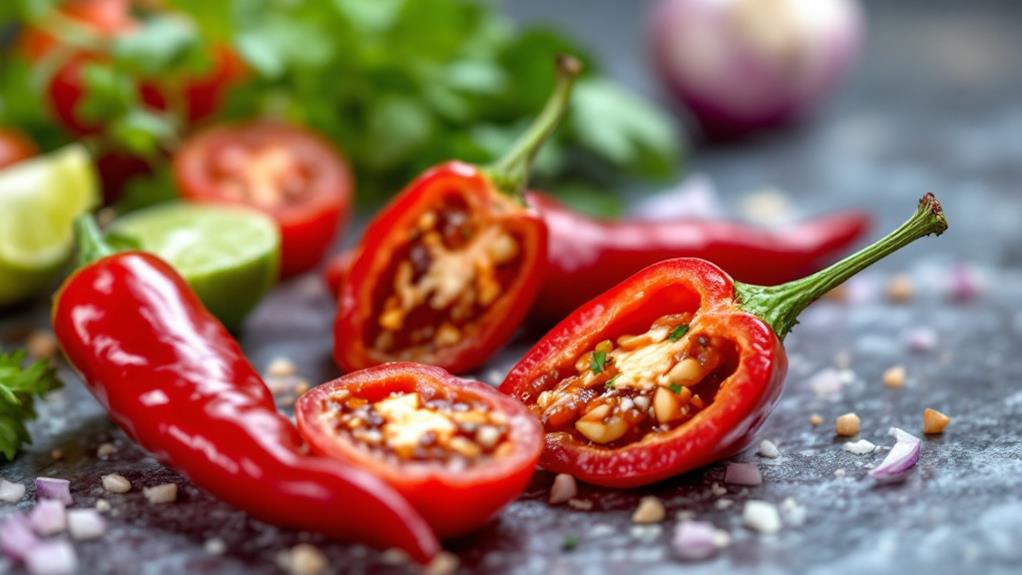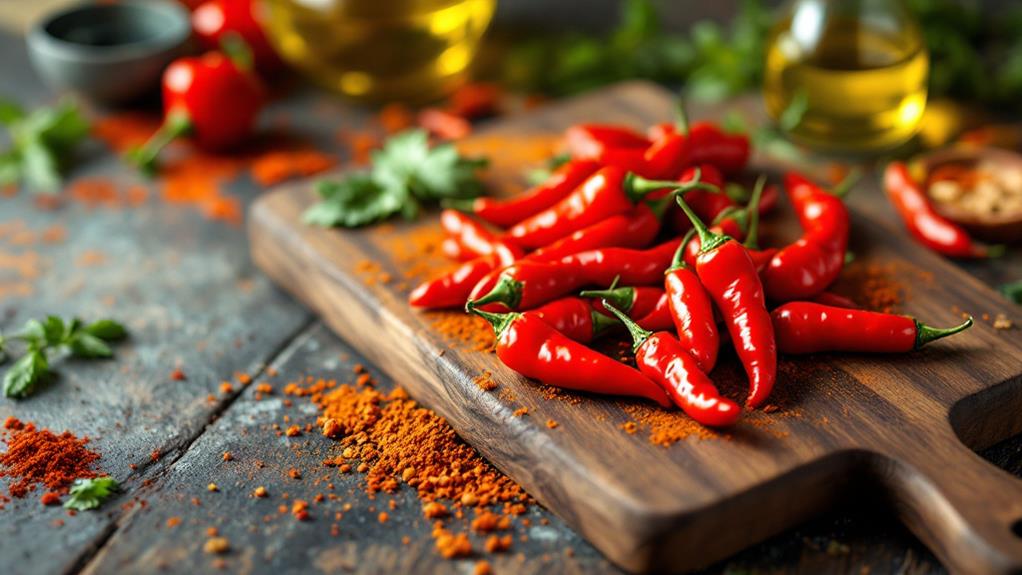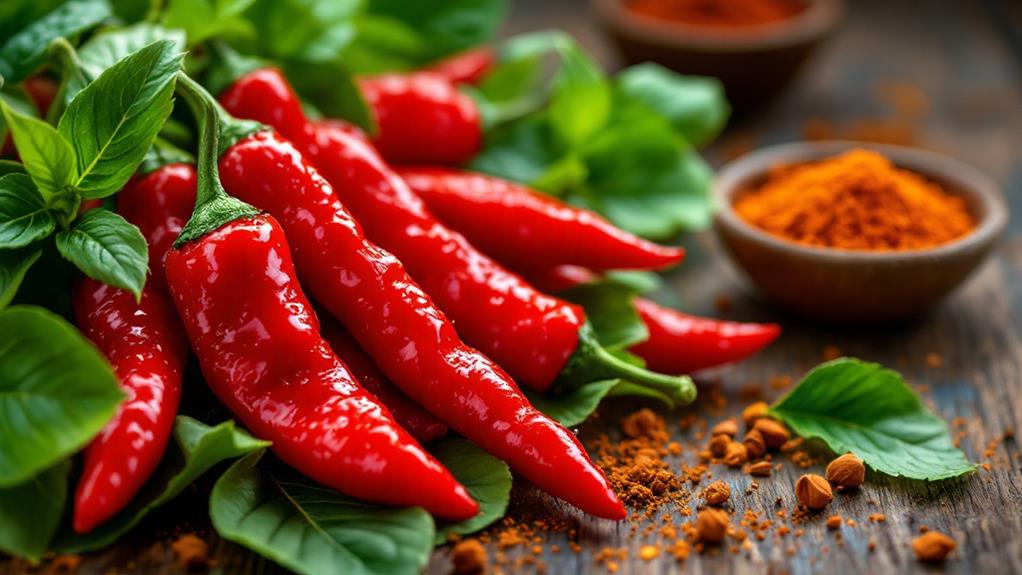The Carolina Reaper Pepper: How to Handle the World’s Hottest Chili
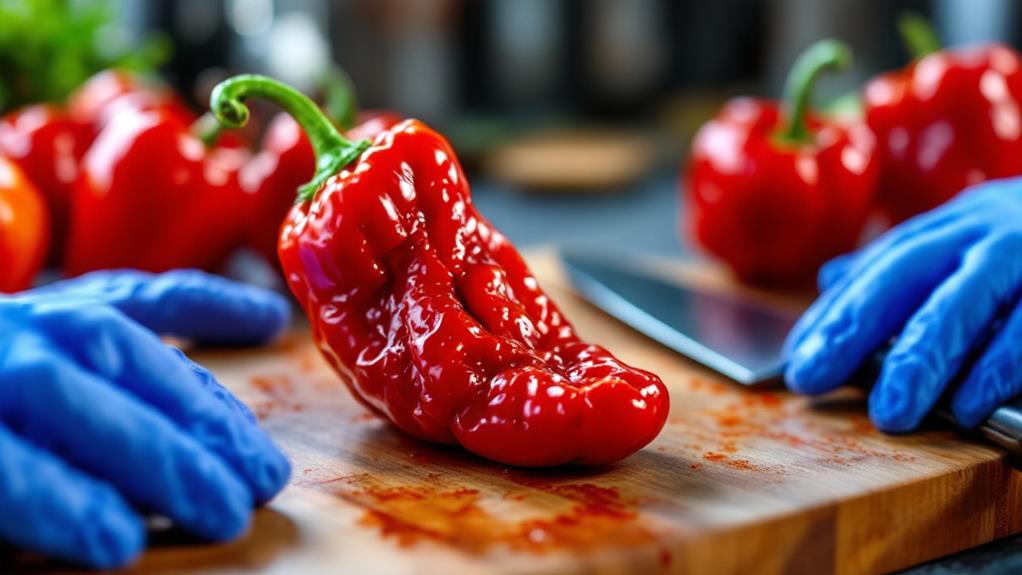
When handling the Carolina Reaper, the world's hottest chili, don't skip precautions. Wear gloves to protect your skin from its intense capsaicin, and consider using a mask and eye protection. Start with a minimal amount to test your tolerance and keep dairy products like milk nearby for relief if the heat gets overwhelming. Avoid touching your face, wash your hands thoroughly afterward, and bear in mind that the burn can be numbing and long-lasting. If you want to investigate the culinary uses and safety tips further to make the most of this fiery pepper, there's much more to uncover.
Understanding the Heat
In relation to understanding the heat of the Carolina Reaper, you're diving into the world of extreme spice. Known as one of the hottest peppers globally, the Carolina Reaper averages around 1,641,183 Scoville Heat Units (SHU), with some peaks surpassing 2,200,000 SHU. This fiery level is attributed to its high concentration of capsaicin, the compound responsible for stimulating nerve endings and causing that infamous burning sensation. When you compare it to milder peppers like jalapeños, which range from 2,500 to 8,000 SHU, or even habaneros at 100,000 to 350,000 SHU, the Carolina Reaper stands out as considerably hotter, about 300 times the heat of the spiciest jalapeño.
As you experience the Carolina Reaper, you're likely to notice a heat perception that's deep and numbing, initially painful, then evolving to an intense, prolonged burn. This isn't just a fleeting sensation; it's a full-bodied experience that can lead to sweating, an increased heart rate, and possible digestive discomfort. Approach with caution, as the Reaper's heat can be overwhelming. Understanding its Scoville Heat Units gives you a sense of its potency, but nothing compares to the firsthand fiery encounter.
Comparing Pepper Heat Levels
Among the world's spiciest peppers, the Carolina Reaper reigns supreme with its staggering average of 1,641,183 Scoville Heat Units (SHU). This makes it the hottest pepper recognized by Guinness World Records since 2013, overshadowing other fiery competitors. If you're curious about how it stacks up, let's compare it to other well-known chili peppers.
Start with the Habanero, which is undeniably hot but pales in comparison to the Carolina Reaper. Habaneros range from 100,000 to 350,000 SHU, meaning the Reaper is several times spicier. Next, consider the Ghost Pepper, or Bhut Jolokia, famed for its intense heat and once considered the hottest pepper itself. It measures between 800,000 to 1,041,427 SHU. While it's still impressively hot, the Carolina Reaper surpasses it with ease.
For a truly mild comparison, think about Jalapeños. With a heat level between 2,500 to 8,000 SHU, Jalapeños are a world apart from the searing intensity of the Carolina Reaper. When you put these chili peppers side by side, it's clear why the Carolina Reaper holds the title of the hottest pepper. Its fiery dominance is unmatched, setting a high bar in the domain of chili peppers.
Effects on the Body

When you take on the heat of a Carolina Reaper, you're not just tasting spice but experiencing an intense physiological reaction. This hot chili, averaging 1,641,183 SHU, can make you sweat and your heart race. The pepper's high capsaicin content triggers these responses. As you consume the Carolina Reaper, your body releases endorphins, sometimes leading to a brief euphoria. However, this sensation can quickly turn into discomfort.
Consuming Carolina Reaper peppers often results in a burning sensation in your mouth and throat, which can linger. To manage this, many find relief in dairy products like milk or yogurt. The pepper can also upset your stomach, leading to pain and digestive issues. Recovery varies; some people feel better in minutes, while others might take hours.
Your sensitivity to this hot chili can differ from others'. Some experience severe headaches, known as thunderclap headaches, after consuming the Carolina Reaper. Nausea is another common aftereffect. The intense heat can surprise your system, so understanding your own tolerance is essential. The Carolina Reaper is not just another pepper; its effects on your body are significant and demand respect.
Safe Handling Tips
Handling the fiery Carolina Reaper requires caution and respect. Known as the Guinness World record holder for the hottest chili, this pepper demands careful preparation. Start by wearing gloves to protect your skin from the intense capsaicin content, which can cause serious burns. This chili averages around 1,641,183 Scoville Heat Units (SHU), so it's vital to be prepared.
In addition to gloves, consider wearing a mask and eye protection. Chopping or cooking releases potent fumes that can irritate your eyes and respiratory system. It's important to avoid any unnecessary discomfort. When you're ready to taste or cook with the Carolina Reaper, start with a minimal amount to gauge your heat tolerance. Even seasoned chili enthusiasts can find its heat overwhelming.
Keep dairy products like milk or yogurt nearby. They're your best allies against the pepper's fiery aftermath, as water won't help relieve the burn. After handling the peppers, wash your hands thoroughly and avoid touching your face, especially your eyes or mouth, to prevent irritation. These steps guarantee you can safely experience the extreme heat of this extraordinary chili without any unpleasant surprises.
Culinary Uses and Precautions
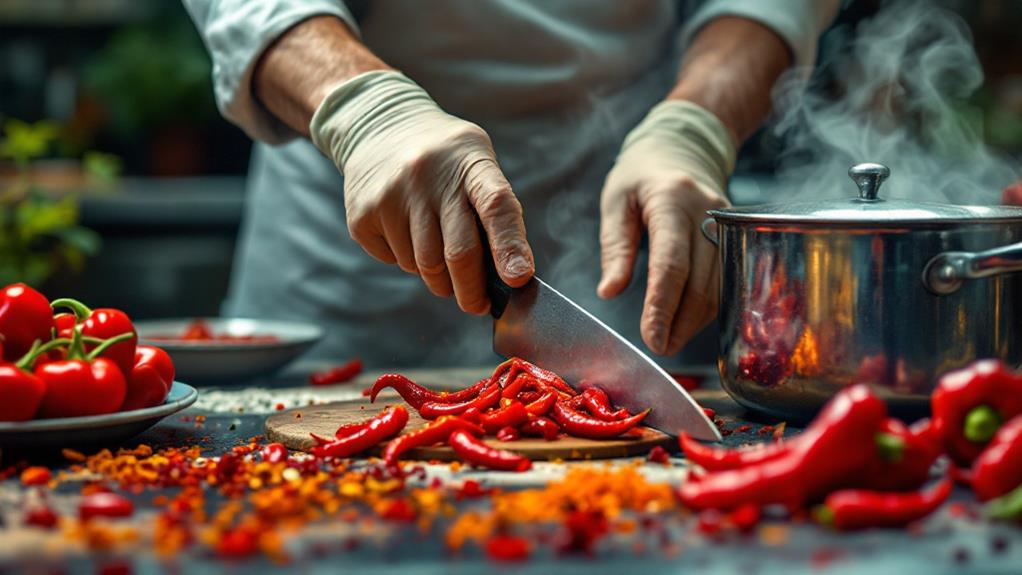
Amplify your culinary creations with the Carolina Reaper's intense heat and unique flavor profile. As the world's hottest chili pepper, it can transform your dishes with just a hint of its fiery presence. Use it sparingly to boost sauces, salsas, and marinades, imparting a deep, warming heat that beautifully complements spicy soups and stews. Start with half a pepper or less to gauge your tolerance and adjust accordingly.
When handling Carolina Reapers, precaution is key. Always wear gloves to prevent skin irritation and wash your hands thoroughly afterward. This helps avoid accidental transfer of the intense capsaicin to sensitive areas like your eyes.
For those who want to enjoy the flavor without overwhelming heat, cooking the peppers briefly can release their unique taste. Pair them with dairy products like yogurt or cream to mellow out the spiciness. Adding sweet ingredients like honey or fruits not only complements the unexpected sweetness of the Carolina Reaper but also helps mitigate some of its heat.

